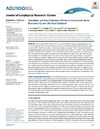Identificador persistente para citar o vincular este elemento:
https://accedacris.ulpgc.es/jspui/handle/10553/72160
| Título: | Variability and Redistribution of Heat in the Atlantic Water Boundary Current North of Svalbard | Autores/as: | Renner, A. H.H. Sundfjord, A. Janout, M. A. Ingvaldsen, R. B. Beszczynska-Möller, A. Pickart, R. S. Pérez Hernández, María Dolores |
Clasificación UNESCO: | 2510 Oceanografía | Fecha de publicación: | 2018 | Proyectos: | Research Council of Norway through the project The Nansen Legacy (RCN 276730) National Science Foundation under grant ARC-1264098 Polish-Norwegian Research Programme under the project PAVE (Atlantic Water Pathways to the Arctic: Variability and Effects on Climate and Ecosystems, contract POL-NOR/202006/10/2013) |
Publicación seriada: | Journal of geophysical research. Oceans | Resumen: | We quantify Atlantic Water heat loss north of Svalbard using year-long hydrographic and current records from three moorings deployed across the Svalbard Branch of the Atlantic Water boundary current in 2012–2013. The boundary current loses annually on average 16 W m−2 during the eastward propagation along the upper continental slope. The largest vertical fluxes of >100 W m−2 occur episodically in autumn and early winter. Episodes of sea ice imported from the north in November 2012 and February 2013 coincided with large ocean-to-ice heat fluxes, which effectively melted the ice and sustained open water conditions in the middle of the Arctic winter. Between March and early July 2013, a persistent ice cover-modulated air-sea fluxes. Melting sea ice at the start of the winter initiates a cold, up to 100-m-deep halocline separating the ice cover from the warm Atlantic Water. Semidiurnal tides dominate the energy over the upper part of the slope. The vertical tidal structure depends on stratification and varies seasonally, with the potential to contribute to vertical fluxes with shear-driven mixing. Further processes impacting the heat budget include lateral heat loss due to mesoscale eddies, and modest and negligible contributions of Ekman pumping and shelf break upwelling, respectively. The continental slope north of Svalbard is a key example regarding the role of ocean heat for the sea ice cover. Our study underlines the complexity of the ocean's heat budget that is sensitive to the balance between oceanic heat advection, vertical fluxes, air-sea interaction, and the sea ice cover. | URI: | https://accedacris.ulpgc.es/handle/10553/72160 | ISSN: | 2169-9291 | DOI: | 10.1029/2018JC013814 | Fuente: | Journal Of Geophysical Research-Oceans [ISSN 2169-9291], v. 123(9), p. 6373-6391 |
| Colección: | Artículos |
Citas SCOPUSTM
67
actualizado el 08-jun-2025
Citas de WEB OF SCIENCETM
Citations
66
actualizado el 08-jun-2025
Visitas
73
actualizado el 03-feb-2024
Descargas
62
actualizado el 03-feb-2024
Google ScholarTM
Verifica
Altmetric
Comparte
Exporta metadatos
Los elementos en ULPGC accedaCRIS están protegidos por derechos de autor con todos los derechos reservados, a menos que se indique lo contrario.
